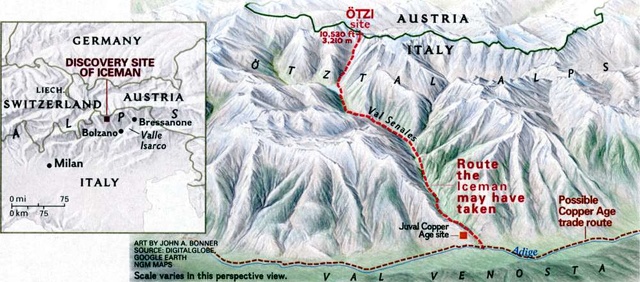Home | Category: Otzi and Copper Age Europe
OTZI, THE ICEMAN
.JPG)
One image of Otzi Otzi the Iceman is the name given to a 5,300-year-old mummified body of a man that was found in a glacier near the border of Italy and Austria. He is the best-preserved prehistoric man ever discovered with his own equipment and clothing. Most ancient human remains are found in burial chambers with carefully selected objects rather than what they use in everyday life. A Viennese journalist coined Ötzi’s name which rhymes with Tootsie and is derived from the Ötzal Alps where he was found and the neighboring Ötzal Valley. [Source: Stephen Hall, National Geographic, July 2007; Bob Cullem Smithsonian, February 2003; David Roberts, National Geographic, June 1993 ]
Some have called the discovery of Otzi one of the most spectacular archaeological discoveries of the 20th century. He is oldest intact human ever found. With the exception of missing toenails, all but one fingernail and an outer layer of skin the Iceman is otherwise perfectly reserved. His body and the tools and clothes found with him have given great insight into a people and age of which little is known in details never preciously imagined.
Each year, thousands view Otzi's mummified remains, which are on display at the South Tyrol Museum of Archaeology in Bolzano, Italy. After Otzi was discovered the world became caught up in Iceman mania. He appeared on the cover of Time magazine and other major publications. T-shirts and jewelry were sold with his sunken eyed beaming out. Pop songs were written about him. A German astrologer announced she was writing a book about her seánces with the Iceman. Other women clamored to be the first to be impregnated with sperm from Ötzi's testicles. Mitochondrial DNA was extracted from Otzi’s bones. A company called Oxford Ancestors, for a fee, will compare your DNA with Otzi’s to see if you are related.
See Separate Article:
DISCOVERY AND STUDY OF OTZI, THE ICEMAN europe.factsanddetails.com ;
OTZI, THE ICEMAN'S CLOTHES, SHOES AND TATTOOS europe.factsanddetails.com ;
OTZI, THE ICEMAN'S HEALTH, DIET AND DISEASES europe.factsanddetails.com ;
OTZI’S DEATH AND FINAL HOURS europe.factsanddetails.com
Good Websites Iceman Photscan iceman.eurac.edu/ ; Otzi Official Site iceman.it ; Archaeology News Report archaeologynewsreport.blogspot.com ; Anthropology.net anthropology.net : archaeologica.org archaeologica.org ; Archaeology in Europe archeurope.com ; Archaeology magazine archaeology.org ; HeritageDaily heritagedaily.com; Livescience livescience.com/
RECOMMENDED BOOKS:
“Otzi, the Iceman” by Angelika Fleckinger (2003) Amazon.com;
“Ötzi, the Iceman: The Full Facts at a Glance” by Angelika Fleckinger (2018) Amazon.com;
“The Glacier Mummy: Discovering the Copper Age with the Iceman” by Gudrun Sulzenbacher (2017) Amazon.com;
“Nova: Iceman Murder Mystery” DVD Amazon.com;
“Nova: Iceman Reborn” DVD Amazon.com;
"Otzi the Iceman" (Digging Up the Past) Illustrated by Amanda Lanser (2014) Amazon.com;
“Life in Copper Age Britain” by Julian Heath (2013) Amazon.com;
“The Life and Journey of Neolithic Copper Objects: Transformations of the Neuenkirchen Hoard, North-East Germany (3800 BCE) by Henry Skorna (2023) Amazon.com;
“The Classification of Chalcolithic and Early Bronze Age Copper and Bronze Axe-heads from Southern Britain” by Stuart Needham (2018) Amazon.com;
“Traditions and Transformations: Approaches to Eneolithic (Copper Age) and Bronze Age Metalworking and Society in Eastern Central Europe and the Carpathian Basin” by Tobias Kienlin (2011) Amazon.com;
Discovery of Otzi, the Iceman
Otzi was found in September 1991 near a 10,500-foot-high pass at the top in the Schnals Valley in Italy, 300 feet from the Austrian border. His head and shoulders had been exposed for around a week, then covered again by a few inches of snow, when he was discovered by a German couple, Helmut and Erika Simon, who were hiking in the area and had wandered off a path. Erika saw him first. She noticed a head and shoulders sticking out of the ice and first thought it was a discarded doll.
Finding the Iceman was an incredible stroke of luck. The snow and ice that had covered him for millennia and preserved him hadn't melted away that long before he was discovered and few days after he was discovered a big snow storm hit the area again that would have covered him again. The shallow basin he was discovered in kept him frozen, preserved and in one piece. If he been in a glacier he would have pulverized into Iceman dust.
Also a stroke of luck was the way his corpse was embalmed in snow and ice soon after he died so that so much could be inferred the body. It seems his body was dried by wind and sun and quickly blanketed by snow and ice in a late spring or early summer snow storm and was situated in a high ravine in such a way that the Niederjoch Glacier flowed over him, preserving him without breaking him apart. Exceptionally warm weather in 1991 melted the ice and allowed him to be found.
Otzi's Profile and Age
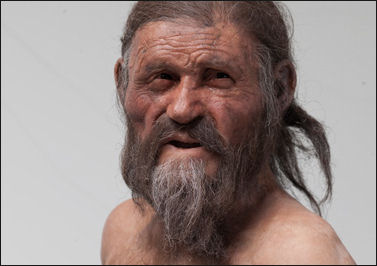 The Iceman lived in 3300 B.C., according to radiocarbon dating, which places him in between Copper and Bronze Age, when metals were first regularly used for tools and weapons. Ötzi was likely like a farmer of a shepherd. Some speculate he was a shaman based on presence of tattoos on his body. His weapons showed he was right-handed, and his clothes gave some rare insights into what prehistoric people actually wore.
The Iceman lived in 3300 B.C., according to radiocarbon dating, which places him in between Copper and Bronze Age, when metals were first regularly used for tools and weapons. Ötzi was likely like a farmer of a shepherd. Some speculate he was a shaman based on presence of tattoos on his body. His weapons showed he was right-handed, and his clothes gave some rare insights into what prehistoric people actually wore.
It is likely that Ötzi was right-handed based on an analysis of wear traces on the chert tools. "His body is a bit more developed on the right side, so it makes perfect sense," Zink told Live Science. He likely spent most of his life farming and herding, and was probably suffering from a painful stomach ache at the time of his death in the Öztal Alps. After more than 25 years of intensive scientific research and extensive media coverage, he is arguably "Europe's Oldest Celebrity." [Source: Kristin Romey, National Geographic, August 18, 2016]
After doing CT scans on the body and performing microscopic examinations of a piece of bone, scientists determined that Ötzi was between 40 to 50 years old. The scientists based their estimate on the presence of degenerative arthritis indicated in the bones and blood vessels. One scientist on team that did the investigation told National Geographic, "Bone and blood vessels within us constantly change throughout life. We were able to see those changes and use them to determine age.”
Otzi's Appearance
Ötzi the Iceman had dark skin and brown eyes and was likely bald. He had a gap between his teeth. Estimates suggest that at the time of his sudden, violent death, he stood about 1.65 meters (5 feet 5 inches) tall, and weighed about 50 kilograms (110 pounds).
According to Live Science; in 2011, researchers gave the iceman a makeover. Using 3-D images of his skull, two brothers assembled an extremely lifelike reconstruction of Ötzi's face. The weather-beaten man had deep-set eyes, a long, hooked nose, and a vague resemblance to actor Harvey Keitel. [Source: Tia Ghose, Live Science, November 9, 2012]
In 2023 Otzi was given another makeover. Based on a detailed study of his DNA, Isaac Schultz wrote in Gizmodo: Ötzi’s skin is also darker than researchers previously thought, and his genes suggest that he was predisposed to baldness. That explains why the mummy was found basically hairless, and contradicts previous reconstructions of how Ötzi looked in life. [Source: Isaac Schultz, Gizmodo, August 16, 2023]
“It was previously thought that the mummy’s skin had darkened during its preservation in the ice, but presumably what we see now is actually largely Ötzi’s original skin color,” said Albert Zink, an anthropologist at the Eurac Research Institute for Mummy Studies and a co-author of the study. Previously it had been said that Otzi had medium length wavy dark hair and wore a beard.
DNA Study Revelations About Otzi’s Heritage
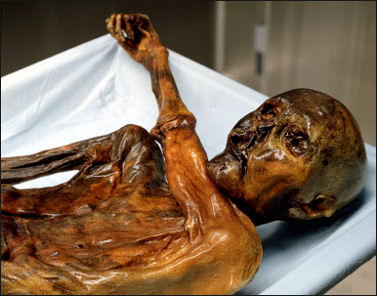
the real Iceman mummy Ötzi’s genome was sequenced in 2012 and produced a surprising result: he was more closely related to present-day Sardinians than he was to present-day Central Europeans that live close to where he was found.. Angela Graefen, a human genetics researcher at the Eurac Institute for the Mummies and the Iceman in Bolzano, Italy, told Reuters. “He is more closely related to modern Sardinian or Corsican populations than, for instance, mainland Italy further to the south. But that doesn’t mean he comes from Sardinia or Corsica. His ancestors were more plausibly from the first wave of migrants from the Near East. The genome group stuck in the isolated regions which were less affected by human migrations, Mediterranean islands but also remote Alpine valleys.” [Source: Michel Rose, Reuters, March 2, 2012]
Thanks to Y-chromosome DNA found in Otzi’s left hip, scientists found that Otzi belonged to a particular so-called Y-chromosome haplogroup that is quite rare among today's Europeans, suggesting his ancestors probably originated in the Middle East, and migrated to Europe as cattle-breeding became more widespread. Today, this genetic heritage is most likely to be found in the inhabitants of islands in the Tyrrhenian Sea, such as Sardinia and Corsica. [Source: Catharine Paddock PhD, Medical News Today, March 1, 2012]
Tia Ghose wrote in Live Science: The initial results didn’t resolve an underlying question: Did most of the Neolithic people in Central Europe have genetic profiles more characteristic of Sardinia, or had Ötzi’s family recently emigrated from Southern Europe? “Maybe Ötzi was just a tourist, maybe his parents were Sardinian and he decided to move to the Alps,” Martin Sikora, a geneticist at Stanford University, said. That would have required Ötzi’s family to travel hundreds of miles, an unlikely prospect, Sikora said. “Five thousand years ago, it’s not really expected that our populations were so mobile,” Sikora told LiveScience. [Source: Tia Ghose, Live Science, November 9, 2012 ||*||]
“To answer that question, Sikora’s team compared Otzi's genome it with those from hundreds of modern-day Europeans, as well as the genomes of a Stone Age hunter-gatherer found in Sweden, a farmer from Sweden, a 7,000-year-old hunter-gatherer iceman found in Iberia, and an Iron Age man found in Bulgaria. The team confirmed that, of modern people, Sardinians are Ötzi’s closest relatives. But among the prehistoric quartet, Ötzi most closely resembled the farmers found in Bulgaria and Sweden, while the Swedish and Iberian hunter-gatherers looked more like present-day Northern Europeans. ||*||
Isaac Schultz wrote in Gizmodo: in 2023, A team of scientists has revisited Ötzi’s genome, first sequenced in 2012, to determine the individual’s ancestry with greater accuracy (The first analysis of the Iceman’s genome was flawed as the sample researchers used was contaminated with modern DNA). The team’s findings were published in Cell Genomics. “We were very surprised to find no traces of Eastern European Steppe Herders in the most recent analysis of the Iceman genome; the proportion of hunter-gatherer genes in Ötzi’s genome is also very low,” said study co-author Johannes Krause, the head of archaeogenetics at the Max Planck Institute for Evolutionary Anthropology, in an institute release. “Genetically, his ancestors seem to have arrived directly from Anatolia without mixing with hunter gatherer groups.” [Source: Isaac Schultz, Gizmodo, August 16, 2023]
For the recent work, Krause’s team sequenced Ötzi’s genome from two samples from the mummy’s left iliac bone and the surrounding tissue. By the team’s measure, the new high-coverage genome has 10 times less contamination than the previously published sequence. Despite being found in what is now Northern Italy, Ötzi apparently came from a lineage from the east that did not mix much with other European groups.
Iceman's Home

where Otzi was found Studies have shown that Otzi was probably was born and lived his whole life within 60 kilometers of the site near the Austrian-Italian border where he was found. The conclusion was reached by studying different elements found in his teeth, bones and intestines and comparing them with those found in soils and water found in different place. The isotopes of element like oxygen, strontium, lead and argon match those in a valley in Italy near where he was found.
Isotopes lodged in teeth enamel are good indicators of what an individual consumed as a child. Those found in bones are good indicators of food consumed in adulthood d while this in the intestines give insights into what a person consumed in his final days. Analysis of the isotopes found in Otzi seemed to indicate he spent his youth in a valley south of where he was found while those in his bones indicate he traveled both north and south of where he was found. Analysis by a team led by Wolfgang Muller of the University of London of lead, strontium and argon isotopes connected with soil type indicated that Otzi likely grew up in the Valle Isarco, an extensive north-south valley that includes the modern-day town of Bressanone. Isotope levels in his bones match those of two Alpine valleys further west — the Val Senales and Val Venosta. Mica found his intestines, likely accidently ingested with stone-ground grain also matches that found in the lower Val Venosta. Based on this evidence it seems likely that the Iceman embarked on his final journey from an area where the modern-day Senales and Adige Rivers meet near the town of Merano — or possibly the nearby Ulten, middle Eisack or lower Puster valleys between Bolzano and the Austrian border. The presence of pollen from a plant not found on the Austrian side of the mountains indicates that he spent his time on the Italian side of the mountains.
Iceman's Tools and Possessions
Among the items found with Iceman were his copper-blade ax, 14 arrows, a firestarter, a birch bark container, a piece of ibex meat, a grass cape, a dagger with an ash handle and flint blade and a sheath, a half-finished yew-wood long bow (longer than a man is tall), a quiver filled with mostly half-finished arrows, an arrow repair kit, medicine, and pieces of antler used to make arrows. He carried embers wrapped in maple leaves placed in a birch bark container, which shows that Neolithic people carried fire from place to place rather that started news fires from scratch. The presence of significant amounts of moss suggest he might have used it to wrap his food or even as toilet paper.
The copper ax was made from malachite — a copper carbonate that appears bluish-green on rock and cliff sides — that was scraped and flaked of the rock and smelted in a crucible over a campfire. The heat of the fire was increased by blowing oxygen through bellows. The nearly pure copper was then poured into a stone mold. This ax showed that people in Alpine possessed technology that was more sophisticated than previously thought. The fact that Otzi possessed such a fine weapon indicated that he was probably an elder in his village, and perhaps a leader.
Otzi also carried a bone needle and piece of fungus on a string that some believe were part of a prehistoric medicine kit. A lot was lost when Otzi was moved. His backpack for example was badly damaged and scientists are not sure how it was worn: over the shoulders or over the head. The quiver he carried has no strap to indicate how it was carried.
Analyzing Ötzi Tool Kit
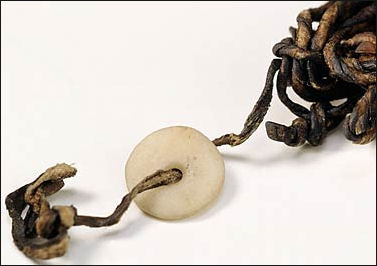
stone disks found on Otzi Laura Geggel wrote in Live Science: Researching such ancient, delicate items was challenging; the scientists had just a few days to examine each of the tools using high-powered microscopes and computed tomography (CT) scans, Wierer said. After that, they had a mountain of data to analyze. [Source: Laura Geggel, Live Science, June 21, 2018]
As part of their exhaustive investigation, Wierer and her colleagues examined the type of chert — a hard, dark rock made of silica — that made up many of Ötzi's tools. They found that the chert came from at least three locations: outcrops in Trentino, Italy, located about 25 miles (40 kilometers) away; rocky places in southwestern Trentino, up to 47 miles (75 km) away; and possibly the Trento Plateau, situated at least 43 miles (70 km) away.
Given the sheer distance between these locations and Ötzi's likely home in the Vinschgau Valley — located in the modern-day province of South Tyrol, Italy — it's possible that Ötzi or his contemporaries traded with people from different regions, Wierer said. "Maybe he did not trade himself, but he [had] some kind of contact with people who traded," Wierer said.
Moreover, an analysis of the cut marks on the tools, as well as the shape of the tools themselves, indicated that Ötzi's belongings incorporated features from two cultures: The arrowheads were typical of the northern Italian tradition, while the end scraper looked like blade tools from the Swiss and southern German lake dwellings of the Horgen culture, the researchers said. Other studies show that there was trade of chert daggers from northern Italy to southern Germany and to Switzerland during the Copper Age. And the copper from Ötzi's ax hailed from what is present-day Tuscany in central Italy, Live Science previously reported. "I think we have to imagine that the trade at the time was already quite far-reaching for certain raw materials and certain products," Wierer said.
Otzi’s Copper Axe and His Links to Central Italy and Copper Making
The copper used to make Ötzi's axe blade did not come from the Alpine region as had previously been supposed, but from ore mined in southern Tuscany. Ötzi was probably not involved in working the metal himself, as the high levels of arsenic and copper found in his hair had, until now, led us to assume. According to the South Tyrol Museum of Archaeology: “One surprising new fact has been unearthed which concerns the most extraordinary item amongst Ötzi's equipment — the valuable copper axe. In contrast to what had previously been presumed, the copper used in the blade does not derive from the Alpine region (researchers had suggested East or North Tyrol as the most likely provenance) but from Central Italy. Professor Gilberto Artioli's archaeometallurgy research group at the University of Padua has discovered that the metal had been obtained from ore mined in South Tuscany. In order to determine its origin, Italian scientists took a tiny sample from the blade and compared the proportion of lead isotope — a kind of "finger print" of the ore deposits which remains unchanged in any objects subsequently made from the ore — with the corresponding data from numerous mineral deposits in Europe and the entire Mediterranean region. [Source: South Tyrol Museum of Archaeology, September 23, 2016]
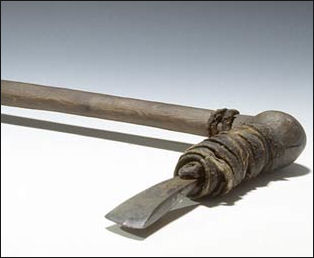
Otzi ax
“The result pointed unequivocally to South Tuscany. "No one was prepared for this finding. We will commission further analyses in order to double-check these first results" stressed Angelika Fleckinger. If the original results are confirmed, this new evidence will give researchers some interesting food for thought. Was Ötzi as a trader travelling possibly as far as the area around today's Florence? What was the nature of the trading and cultural links with the south in those days? Did the exchange of goods also involve movements of the population? That is to say, did people from the south venture into the Alpine region and vice versa? "This is a particularly exciting insight especially with respect to questions about population development," explained Albert Zink.
“Another question long debated amongst the scientific community, is whether Ötzi was perhaps involved himself in the process of copper smelting. Scientists have advocated this thesis because raised arsenic and copper levels have been measured in the mummy's hair, a fact which might possibly be explained, for example, by breathing in the smoke which is released when melting and pouring metal. Geochemist Wolfgang Müller of Royal Holloway, University of London, who had already used isotope analysis to establish Ötzi's South Tyrol origins, has now turned to this question once more.
“Using highly developed methods of analysis such as laser mass spectrometry and speciation analysis, Müller's team examined not just hairs but also samples from Ötzi's nails, skin and organs for possible heavy metal contamination. His, so far still provisional, findings suggest that the hypothesis that Ötzi was involved in processing metal was premature. Müller did indeed find slightly raised arsenic values in the nail sample, but not in other tissue samples. Raised copper levels were only present at the extremities and this correlates with other change indicators, and thus it is doubtful if one can establish a heavy metal contamination for Ötzi's actual life time: raised values might also be due to environmental influences over the 5,000 years since his death.”
Otzi, the Hunter, and His Weapons
Otzi’s hand slings and the design of his long, lightweight arrows indicate that he specialized in hunting ibex and mountain goats that live high above the tree line. Arrows of his design would not work well in the forest where they can get tangled up in brush. The feathers of the arrows indicate that people in Otzi’s time understood that the aerodynamic principal of a rotating arrow could be shot more accurately.
According to Archaeology magazine: The 14 arrows found in Ötzi’s doeskin quiver were made from branches of the wayfaring tree. Two of these arrows were ready to be fired, a trio of feathers still stuck to their ends with birch tar glue and nettle fibers. This design, with feathers arranged to produce a straight flight path, has remained virtually unchanged since. [Source: Daniel Weiss, Archaeology magazine, May-June 2020]
Otzi’s ash-handled flint dagger was probably used to cut leather and slice game. X-ray, CT scans and chemical analysis showed the unfinished bow was made of a yew tree cut lower down the mountain and arrows were tied to their shafts with sinew. Evidence shows also that Otzi retied his arrows, butchered animals with his flint knife and worked to reposition his copper ax head in its handle.
Otzi’s curved spike, edge sharpeners for his stone tools, and quiver were made from red deer skin or antler. Red deer bones were often fond in Neolithic sites. They were are common source of meat. Some scholars have speculated that Europe’s first forests were purposely cleared to create ideal conditions for hunting large red deer.
Iceman's Route
The Iceman died on a fairly well-traveled route from the Schnals Valley in Italy across Tisenjock Pass to the high pastures on the Austrian side of the Alps. It is believed he was on his way to the fertile Venosta Valley in northern Italy, where he may have had a home. Excavations have uncovered numerous stones tools along the route.
Ötzi was likely a farmer or a shepherd on his way to or from the summer pastures nearby. Nobody is sure what he was doing up on the pass. Some speculate that his tattoos meant he was a shaman and that maybe he was up there performing some kind of ritual but most believe he was a shepherd gathering materials for new weapons. In addition to a deerskin quiver 12 unfinished arrows were found. Based on evidence that he hunted perhaps he was where he was to hunt ibex.
Judging from grain samples it was determined that the Iceman left a lowland valley in late summer or early autumn and the speculate the broken ribs may have meant that he was fleeing a violent confrontation. The fact that pollen of deciduous trees and pine trees was found on food in his intestines suggests he doubled back through a forest before climbed to the peak, as if try to elude pursuers.
Image Sources: Otzi Museum, Wikimedia Commons, map from National Geographic
Text Sources: National Geographic, New York Times, Washington Post, Los Angeles Times, Smithsonian magazine, Nature, Scientific American. Live Science, Discover magazine, Discovery News, The Times of London, Natural History magazine, Archaeology magazine, The New Yorker, Time, BBC, The Guardian, Reuters, AP, AFP, Lonely Planet Guides and various books and other publications.
Last updated May 2024

